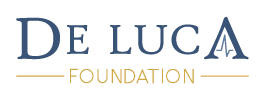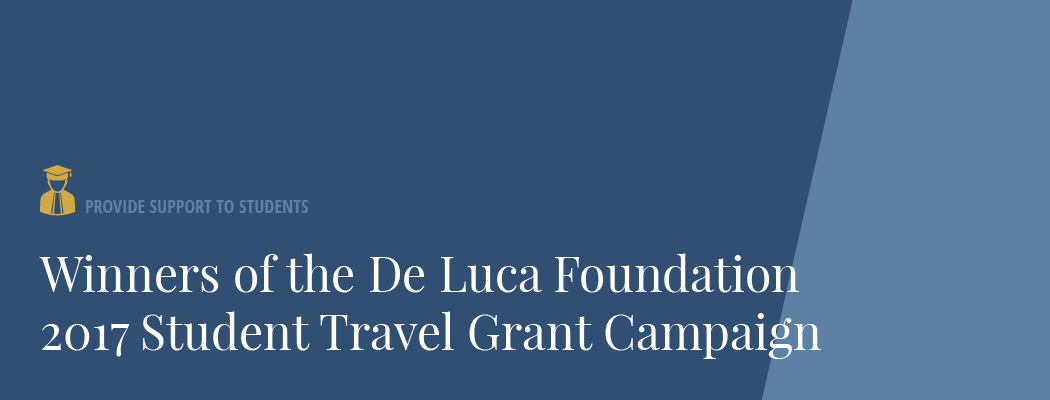The De Luca Foundation is pleased to announce the winners of our 2nd annual Student Travel Grant campaign.
In this second year of the Student Travel Grant campaign, we received a total of 277 applications, far surpassing last year’s mark of 140 applications. As an organization dedicated to supporting scientific advancement, it is spectacular for the De Luca Foundation to see so many young scholars eager to put forth their unique research and hone their academic merit. We look forward to following their career progression as they develop into seasoned scientists and researchers, each contributing their own work to the greater scientific community.
After diligent review of all the applications, we have selected 20 winners for the 2017 Student Travel Grant. Awards are in the amount of $400 USD per applicant.
We thank all that applied for the 2017 Student Travel Grant, and we invite all students to consider applying for the grant in 2018. Applications will open towards the beginning of next calendar year.
The list of winners is as follows, organized by conference:
International Society of Biomechanics
Jocelyn Hafer
University of Massachusetts, Amherst
“The role of muscle function in gait mechanics at the knee: Older vs. young adults”
Allison Clouthier
Queen’s University
“Effect of articular geometry on patellofemoral joint function”
Melissa Boswell
Stanford University
“The Effect of Brain Size on Inducing Traumatic Brain Injury”
Simon Franklin
University of Birmingham
“Impact of Footwear and Ageing on Gait and Muscle Activation”
Maurice Mohr
University of Calgary
“Muscle co-contraction index in young adults with and without previous knee injury – Intrarater reliability during gait”
Ian Russell
University of Southern California
“A novel four-axis parsing of shoulder net joint moment in manual wheelchair propulsion”
Sebastian Becker
Rheinisch-Westfälische Technische Hochschule Aachen University
“Time-frequency coherence of categorized sEMG data during dynamic contractions of biceps, triceps and brachioradialis as an approach for spasticity detection”
Jia Liu
University of Southern California
“Sex Differences in Hip Extensor Muscle Activation During the Late Swing Phase of Running: Implications for Altered Frontal Plane Hip Kinematics”
Paula Pelicioni
Neuroscience Research Australia
“Gait Stability is Affected By Antiparkinsonian Medication in Parkinson’s Disease Subtypes”
Davide Pavan
University of Padua
“Effectiveness and injury prevention during rugby tackle: an on-field, biomechanical based assessment”
David Williams
Cardiff University
“Relationship between frontal plane alignment and biomechanical performance of total knee replacement using dynamic fluoroscopy and gait analysis of a unique patient population”
American Society of Biomechanics
Farzad Ehtemam
University of Maryland
“Application of Harmonic Transfer Functions Method of Analysis to Understand Responses to Mechanical Perturbations in Human Walking”
Zachary Adams
University of Delaware
“Rate Coding and Recruitment of Elbow Flexion Agonists”
Brian Cohn
University of Southern California
“Neuromechanical Implications of Postural Changes to Motor Learning and Performance”
Samuel Acuna
University of Wisconsin-Madison
“Individuals With A Prior Traumatic Brain Injury Exhibit Decreased Neuromuscular Complexity During Gait”
K. Michael Rowley
University of Southern California
“Perturbation of systems contributing to neuromotor control of posture in persons with recurrent low back pain”
Lauren Schoreder
University of Tennessee – Knoxville
“Knee Adduction Moment and Muscle Activation During a Sidecut on a Raised Surface”
Alison McDonald
McMaster University
“Submaximal Normalizing Methods to Evaluate Load Sharing Changes in Repetitive Upper Extremity Work”
American College of Sports Medicine
Nathan Wages
University of Oklahoma
“Unilateral fatiguing exercise and its effect on relative, percent change differences between vastus lateralis muscles”
Michelle Aube
High Point University
“Muscle Activation Patterns during a Novel Lateral Lunge Jump Reaction Test”

